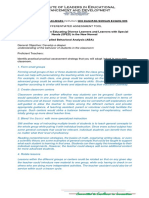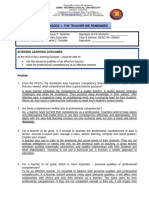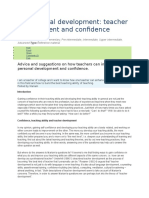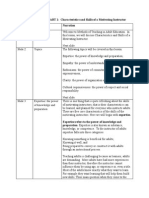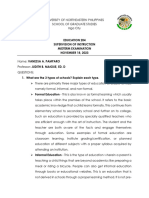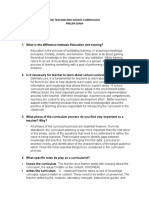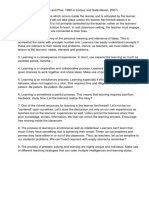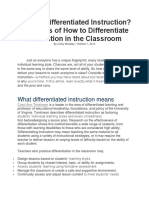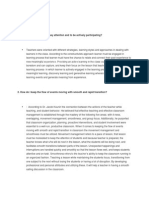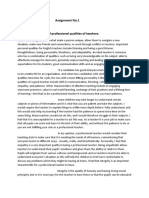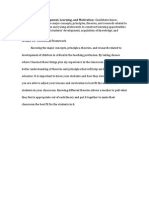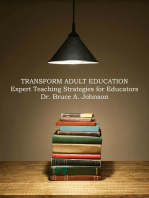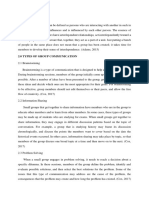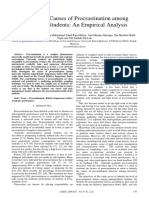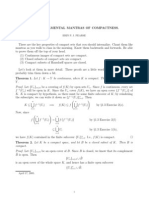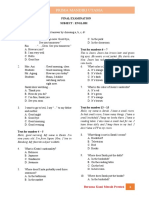0 ratings0% found this document useful (0 votes)
67 views2 pagesWhat Is Considered A Multi-Level Class?
A multi-level class refers to a group of learners with varying English proficiency levels, as well as differences in educational background, culture, learning styles, personalities, age, and goals. Teaching a multi-level class requires creativity from the teacher, such as planning different lessons and objectives for different proficiency levels or teaching to the middle with leveled tasks. Activities should engage and challenge learners without causing frustration. Personalization connects learners' experiences and opinions to class content, making learning more meaningful. Lack of authority occurs when a teacher loses ability to control a group due to poor communication, organization, humility, or qualifications, confusing and frustrating students. Teachers can foster student autonomy by developing their own autonomy first
Uploaded by
Edo RazielCopyright
© © All Rights Reserved
Available Formats
Download as DOCX, PDF, TXT or read online on Scribd
Download as docx, pdf, or txt
0 ratings0% found this document useful (0 votes)
67 views2 pagesWhat Is Considered A Multi-Level Class?
A multi-level class refers to a group of learners with varying English proficiency levels, as well as differences in educational background, culture, learning styles, personalities, age, and goals. Teaching a multi-level class requires creativity from the teacher, such as planning different lessons and objectives for different proficiency levels or teaching to the middle with leveled tasks. Activities should engage and challenge learners without causing frustration. Personalization connects learners' experiences and opinions to class content, making learning more meaningful. Lack of authority occurs when a teacher loses ability to control a group due to poor communication, organization, humility, or qualifications, confusing and frustrating students. Teachers can foster student autonomy by developing their own autonomy first
Uploaded by
Edo RazielCopyright
© © All Rights Reserved
Available Formats
Download as DOCX, PDF, TXT or read online on Scribd
Download as docx, pdf, or txt
Download as docx, pdf, or txt
You are on page 1/ 2
ESL Teaching Techniques Adriana Margarita Herrera Fey
Questions Session 4 Saturday, September 9th, 2017
1. What is considered a multi-level class?
It is referred to as a group of learners within a similar range of age who have varied
proficiency levels of English. This is to say that some are stronger in the language than
others, fact which is very challenging for the teacher. Language though, is not the only issue
that makes a class a multi-level one. Features such as learners’ educational background,
cultural expectations, learning styles, learners’ personalities, even their age, goals and so
on are part of the things that make the members of a group heterogeneous.
Given that instructors will rarely find a homogeneous group to teach, there are different
techniques that can be used to cater for these needs, being one of the most common ones
the planning of different lessons with different objectives for the different proficiency levels
in the class, while students work in groups at their own pace and abilities. This requires
much creativity from the teacher apart from being time consuming. Another technique is to
“teach to the middle” and then planning different, appropriate, leveled tasks depending on
the students.
A teacher must bear in mind that the activities should be challenging enough to engage
the learners, but not so difficult as to generate a feeling of frustration and surrender.
2. How do you make student's works individual and personal?
As mentioned in my request in “padlet”, this question is quite vague, but since I didn’t get an
answer, I gave it my own interpretation. This question may have to do with engaging learners
in the activities and subjects that we plan as teachers.
Personalization is a technique used by teachers to help achieve this goal, and it means
connecting learners’ experiences, ideas opinions, preferences and feelings with what goes
on in the class. It also allows them to communicate real information about themselves, thus
making learning more relevant and meaningful.
3. What is lack of authority?
It refers to when the teacher has lost or never gained the moral ability to control a group of
people for a particular area or activity. This may be due to several reasons, some of which
might include the following:
a) Poor communication, being unable to convey meanings and messages – This may
cause confusion when delivering instructions or giving explanations, making learners
feel anger, frustration apart from confusion.
b) Poor organization, which makes the teacher difficult to be followed and making students
struggle with the teacher’s requirements – This may also cause the same feelings of
confusion, anger and frustration.
c) Poor sense of humility and high sense of arrogance. This teacher may feel the students
feel dumb while being corrected or stating their point of view which in turn may cause
anger in them.
d) Poor qualifications, which make teachers vulnerable to more prepared students who
might question them maybe not to challenge them, but to clarify information which is now
confusing. It is evident for the students when the teacher does not master the topic. This
also includes the teacher who doesn’t read the learners’ homework and doesn’t give
feedback on their progress since students are expecting some kind of comment on
assignments that have taken time and effort to be done.
4. How do you make your students feel autonomous?
Learner autonomy refers to the idea of having the student shoulder the responsibility of
their own learning. It has to do with taking the initiative in identifying their own needs,
planning their own learning goals, being able to identify material resources for learning and
choosing the proper strategies to have positive outcomes in learning, all which in my
perspective are closely related to personality and commitment rather that to outer influencing
factors. Nevertheless, there are several ways to help students reach their autonomy, but it
is probably developing teacher autonomy the most important characteristic of an instructor
that will lead him/her to then, help the students be independent as well.
After becoming an autonomous teacher it is compulsory to find out more about the
learners. Once having more information, it is important to work on their motivation, help them
develop their learning strategies, building a sense of community, and helping them self-
monitor.
You might also like
- Lecture Notes-Basic Electrical and Electronics Engineering-Unit 188% (17)Lecture Notes-Basic Electrical and Electronics Engineering-Unit 130 pages
- Project Control For Construction CII P6 - 5 PDFNo ratings yetProject Control For Construction CII P6 - 5 PDF52 pages
- HMEF5073 - V2: Your Answer: The Curriculum Is A Route Map For Learning Which Has An Objective ToNo ratings yetHMEF5073 - V2: Your Answer: The Curriculum Is A Route Map For Learning Which Has An Objective To11 pages
- Committed To Excellence in Innovation: Differentiated Assessment ToolNo ratings yetCommitted To Excellence in Innovation: Differentiated Assessment Tool8 pages
- Allama Iqbal Open University Islamabad: General Method of TeachingNo ratings yetAllama Iqbal Open University Islamabad: General Method of Teaching27 pages
- Phase 1 –Recognition of the course- Carolina JarabaNo ratings yetPhase 1 –Recognition of the course- Carolina Jaraba8 pages
- EDU 528, WEEK 3, PART 1: Characteristics and Skills of A Motivating Instructor Slide # Topic NarrationNo ratings yetEDU 528, WEEK 3, PART 1: Characteristics and Skills of A Motivating Instructor Slide # Topic Narration8 pages
- Hannah Enanod - WS 2 Individual Differences and Learners' InteractionNo ratings yetHannah Enanod - WS 2 Individual Differences and Learners' Interaction3 pages
- Assessment and Planning (AutoRecovered)No ratings yetAssessment and Planning (AutoRecovered)151 pages
- Principles of Learning (Horne and Pine, 1990 in Corpuz and Salandanan, 2007)No ratings yetPrinciples of Learning (Horne and Pine, 1990 in Corpuz and Salandanan, 2007)7 pages
- Allama Iqbal Open University, IslamabadNo ratings yetAllama Iqbal Open University, Islamabad17 pages
- Unit 2. Profile of a Learner Centered TeacherNo ratings yetUnit 2. Profile of a Learner Centered Teacher6 pages
- 1 - The Practice of English Language Teaching Chapter 6 (Summary100% (1)1 - The Practice of English Language Teaching Chapter 6 (Summary6 pages
- Transform Adult Education: Expert Teaching Strategies for EducatorsFrom EverandTransform Adult Education: Expert Teaching Strategies for Educators5/5 (2)
- Sri Satyanarayna Vrat Katha Plus Narrative PDF100% (1)Sri Satyanarayna Vrat Katha Plus Narrative PDF59 pages
- Erin P. J. Pearse: α α∈A α − 1 α α − 1 α 1 i n i=1 n − 1 i n − 1 iNo ratings yetErin P. J. Pearse: α α∈A α − 1 α α − 1 α 1 i n i=1 n − 1 i n − 1 i2 pages
- Ethics in The Practice of Petroleum Engineering: Denver Chapter of SPEENo ratings yetEthics in The Practice of Petroleum Engineering: Denver Chapter of SPEE27 pages
- Subsea Subsea: Subsea Topside Subsea TopsideNo ratings yetSubsea Subsea: Subsea Topside Subsea Topside5 pages
- Brent Berlin-Covert Categories and Folk TaxonomyNo ratings yetBrent Berlin-Covert Categories and Folk Taxonomy10 pages
- Magento Community Edition User Guide v.1.9No ratings yetMagento Community Edition User Guide v.1.9746 pages
- Glossary: API Specification 10A and API Recommended Practice 10B0% (1)Glossary: API Specification 10A and API Recommended Practice 10B7 pages
- The Dynamics of Real Asset Prices, The Real Exchange Rate, Trade Reforms and Foreign Capital InflowsNo ratings yetThe Dynamics of Real Asset Prices, The Real Exchange Rate, Trade Reforms and Foreign Capital Inflows29 pages









